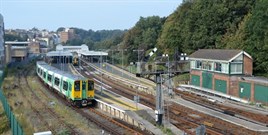RAIL’s Open Access pages were set alight with debate in 2014, after RAIL fares expert Barry Doe described the plan to bring High Speed 1 trains to Hastings as “the most ridiculous I have ever heard in half-a-century of railway ideas” (The Fare Dealer, RAIL 748).
Yet, despite the technical constraints, the concept of running HS1 trains to Hastings is perhaps an obvious and proven one. After all, sleek blue Hitachi Class 395 Javelins whisk commuters down the newer line, and then at Ashford and Ebbsfleet trundle off onto the classic network to places such as Canterbury, Dover, Faversham, Margate and Ramsgate.
Even some of Kent’s less populous towns and villages have gained HS1 benefits, with a new route taking in more of the coastal destinations such as Deal, Martin Mill, Sandwich and Walmer under the Integrated Kent franchise currently operated by Southastern.
At a local rail summit in March 2014, Conservative MP for Hastings Amber Rudd championed the extension of the HS1 network to serve the town.
With a population of 139,271 (more than Bedford, but fewer than St Albans), Hastings is the 65th largest settlement in the UK. And with the support of Secretary of State for Transport Patrick McLoughlin, who gave an “absolute commitment” to the scheme at the summit, it appeared that the battle to win faster, better-quality and higher-capacity train services to London had been won.
Or had it? While there is no detection of any disagreement among local politicians, the business community and passenger groups that HS1 trains to Hastings would be anything other than beneficial for the area, RAIL understands that the finance and the project resources for such a scheme remain somewhat sketchy. Also, ministerial assurance is far from a done deal.
Local leaders want journey times to improve, thereby making Hastings a better option for potential investors in the area, as well as making life easier for London commuters from the town (it is hoped this market can expand).
It is a town bristling with opportunity and potential. But as Hastings Borough Council Leader Jeremy Birch is keen to point out to RAIL, it is also a town with concerns over the more immediate disruption caused by the rebuilding of London Bridge, which is used by many Hastings-London commuters.
“Hastings-Charing Cross won’t stop for 18 months, and Hastings-Cannon Street won’t stop for 18 months after that - with three years of disruption,” says Birch. “We don’t think that Southeastern has adequately advertised the fact that this is going to happen.”
Birch suggests that to try and tackle the potential disruption, Hastings travellers should be allowed to travel via HS1, changing at Ashford. After all, landslips last winter near Crowhurst and West St Leonards led to Ashford and St Pancras being allowed on the standard ‘non-HS1’ fare for a brief period.
Rail services are important to Hastings - a hardy contingent makes the journey to the central London terminus stations of Charing Cross and Cannon Street. But for Birch, good rail services aren’t just about getting commuters to London, they’re also about bringing people into the town - to live in and buy property, and to work.
“Hastings is getting a better public profile and better press, and a cultural agenda. You need to get people here and enjoy the cultural offer,” he says, with an eye on the 950th anniversary of the Battle of Hastings coming up in 2016.
“There is a movement of creative and cultural people into our area from Brighton and London - you can get a character property in Hastings for a fraction of what you could sell your London flat for.”
All of the above are important for the people the council wants to attract, while travel times are also “really important”, according to Birch.
An easier Hastings-London St Pancras commute of around 68 minutes is envisaged, comparing favourably with the one-hour London Victoria-Brighton journey. And despite the present 1hr 40mins London journey time, Hastings can already compare favourably with Brighton - Victoria is “out on a limb”, and the choice of Charing Cross, Cannon Street or St Pancras International (the latter involving a change at Ashford) offers better connectivity for West End and City-headed commuters.
However, Birch knows that the HS1 option is the only realistic way of speeding up London journey times.
“It’s important for continued regeneration,” he says. “The cost of improving by 15-20 minutes our line to Charing Cross is extremely expensive, because of the tunnels, which are inadequate.”
What about McLoughlin’s “absolute commitment”? With no firm plans at present, Birch says he accepts that the case has to be made.
“We are funding a business case examination. Mott McDonald will deliver it. We need to make the case that it is a better investment than £120 million in the North of England or the Midlands. We will develop a business case for argumentation why this is justified.”
It’s Network Rail’s job to make the technical case. In order to make use of the HS1 infrastructure arriving from Hastings, trains arriving at Ashford International from a westerly direction will (using a solution yet to be identified) need to cross the station to reach HS1. As yet, the required switches or crossings do not exist, let alone anything more substantial, while signalling would also need to re-configured.
Then there is the question mark over what type of electrification is installed, as well as whether to include any level of dualling on the existing Marshlink route to Ashford.
NR is carrying out some as yet unpublished route studies, with Lead Development Manager Andrew Wood tasked with looking at the Hastings-Tonbridge line.













Login to comment
Comments
No comments have been made yet.